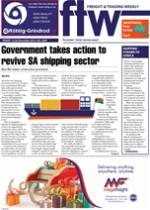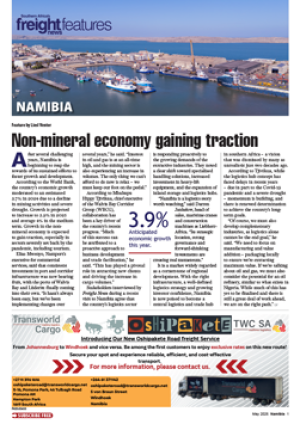Is the Far East trade still
a one-way wonder, with
a serious import/export
imbalance on the westeast
leg?
It’s arguably getting more
balanced, according to Iain
McIntosh, regional sales
manager of MOL. “While
the trade is traditionally
westbound-dominant,” he told
FTW, “there
are clear
signs that
eastbound is
closing the
gap. This is
not in TEU
terms. But
it is getting
closer due to
eastbound
cargo
being a lot
heavier than
westbound -
nearly double
the weight per
slot eastbound in some cases.
So we see growing balanced
trade in 2014-2015.”
However, Matt Conroy,
trade and marketing manager
of Maersk Line, didn’t take
the same stance. “Certainly,
the export market has grown
faster than the import market,”
he said. Thus the gap has
closed slightly. But he felt there
was still a
“significant”
imbalance.
The
fortunes on
the trade have
been relatively
limited this
year.
From
Conroy’s
records, the
first quarter
import
demand was
strong, with
double-digit
growth. “But
since then,” he added. “the
market has been relatively
flat.”
There are many factors
playing into this, according
to Conroy. “But the rate of
exchange and lower consumer
consumption/confidence play a
large part.”
Maersk anticipates
import growth for 2014, but
at what Conroy described
as “a moderate level, low
single digits”. The line also
anticipates that export growth
will be slightly above import
growth in 2014.
Lance Pullan, GM, CSAV
Group Agencies SA, looked
at the trade from an export
perspective from SA to the Far
East.
“The volume there has
been relatively consistent,” he
told FTW, “despite volatility
in commodity prices. The
expectation is that this trend
will continue into 2014 – with
volumes increasing as the Far
East begins to recover from the
global recession.”
McIntosh described the
trade as having been stable on
imports, but only just, with
moderate growth. This he
deduced from the sea trade
growth being below national
growth by an approximate
1%-2% over
2012.
“Export
volume,
however, has
grown very
well this year,”
he said, “at
approximately
10%.” He did,
though, note
that these
were national
trade figures
– not just
purely MOL
growth. “They
will vary, I
suspect,” he said.
The “cascade” principle,
where vessels have been
redeployed down into the
north-south trades as the eastwest
trades have been flooded
with mega-container ships
has led once again to capacity
challenges on the SA-Far East
run.
But,
according
to Pullan,
the freight
rates have
remained
stable despite
the increase
in capacity
as most lines
cascade
bigger vessels
down onto
this trade.
“However,”
he said, “the
challenge is
to optimally
use this additional capacity
given the port restrictions
being faced in SA.” This where
the relatively low draught at
most of SA’s major container
ports doesn’t yet allow these
larger capacity vessels to sail
fully laden. However, the main
SA port of Durban (which
handles 80% of SA’s container
sea trade) is busy deepening
its container berths to a 16.5m
draught – ample for even
mega-ships.
McIntosh described the
freight
levels as
“flat”. “But,”
he said,
“in spite of
this, rate
levels have
remained
stable, as
supply/
demand has
remained
more or less
the same.”
He did,
however,
add that a general rates
restoration (GRR) “would have
been helpful”.
When asked if there were
any markets of particular
growth, or new trends, Pullan
pointed out that there had
been a bit of a switch away
from the main East Asian
market in China. “There
has been greater interest in
shipping to smaller Asian
countries rather than China,”
he said. But, he added, the
volumes here are still very
small.
Conroy, meantime, pointed
out that the commodity export
market still remained strong.
Given
the market
conditions
described by the
FTW contacts,
we asked if there
had been any new
developments
within their
companies
related to this
trade.
Pullan focused
primarily on
the fact that, in
August, CSAV
– along with its partner lines –
upgraded all vessels on its Far
East service from 6 500-TEU
to 8 500-TEU capacity ships.
Conroy, however, told
FTW that Maersk’s focus on
schedule reliability continued
to be a significant driver on the
Far East trade.
When asked if MOL had
introduced larger tonnage
vessels on this trade. McIntosh
said that there was a moderate
upsize in the line’s ASA service
tonnage. “But,” he added, “this
was more to do with balancing
its ship system.”
Looking ahead, McIntosh
stressed that there might be
some tighter space westbound
from Asia in the first and
second quarters of 2014. This,
he added, would be mainly as
a result of massive capacity
reduction on the Asia–East
Coast South America (ECSA)
trade – while noting that a
number of services are trunk
lines.
“The crunch could be
tighter,” McIntosh told FTW,
“as Asia–ECSA westbound
is starting to show some
increasing growth after a
flat last two years. This
whilst the eastbound trade
from ECSA to Asia has been
growing at 14% per annum
consistently for the last three
years.”
And it will be noticed in this
country. “This can have strong
impact on way-port capacity
in SA,” said McIntosh.
INSERT & CAPTION 1
The eastbound trade
from ECSA to Asia
has been growing
at 14% per annum
consistently for the
last three years.
– Iain McIntosh
INSERT & CAPTION 2
The challenge is to
optimally use this
additional capacity
— as bigger vessels
are cascaded down
— given SA’s port
restrictions.
– Lance Pullan
INSERT & CAPTION 3
Maersk anticipates
import growth
for 2014, but at a
moderate level, low
single digits.
– Matt Conroy
CAPTION
Smooth sailing ... a fine balancing act on the westbound-dominant trade.

